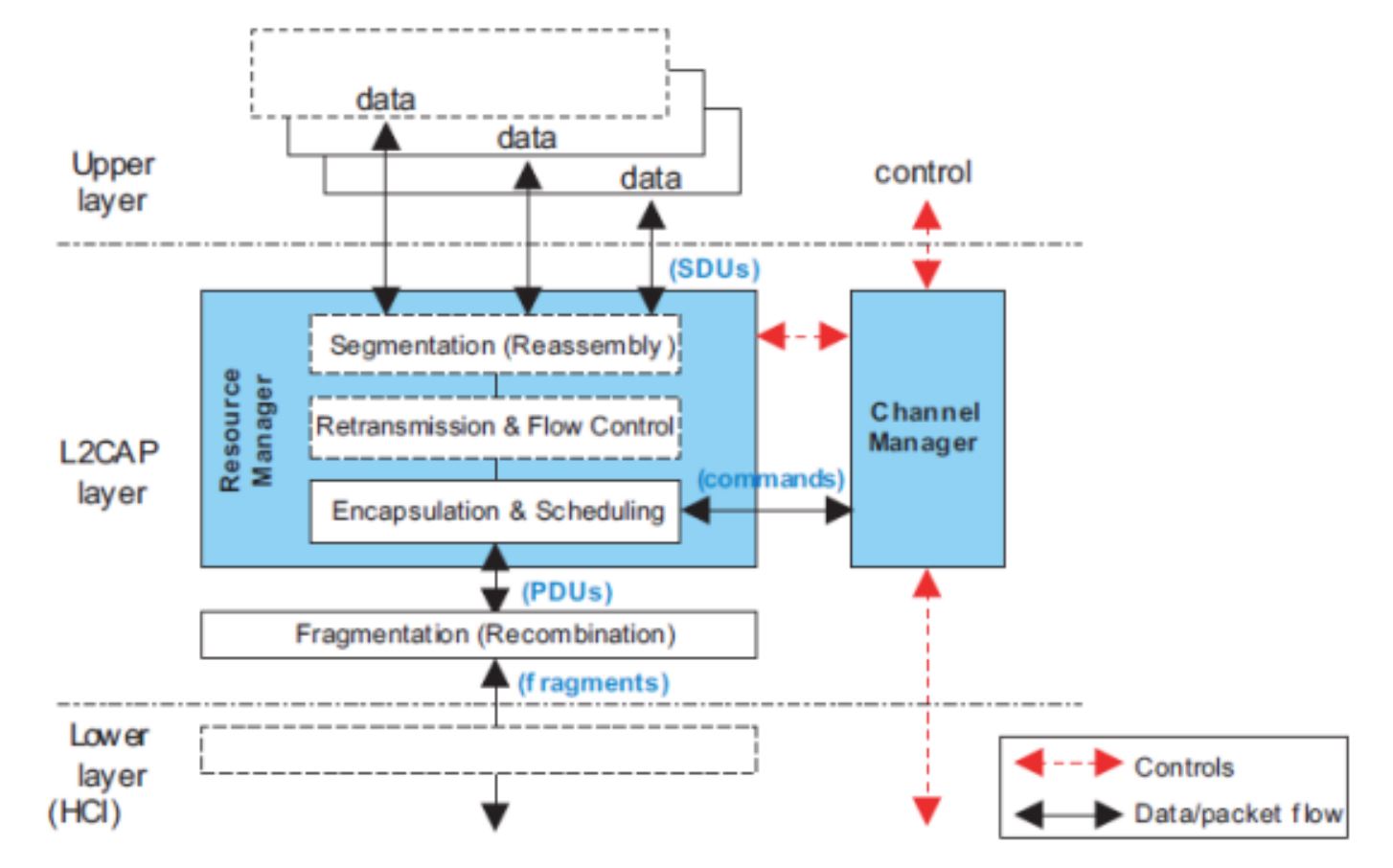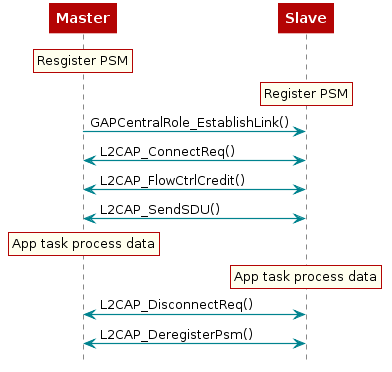Logical Link Control and Adaptation Layer Protocol (L2CAP)¶
The L2CAP layer sits on top of the HCI layer on the host side and transfers data between the upper layers of the host (GAP, GATT, application) and the lower layer protocol stack. This layer is responsible for protocol multiplexing capability, segmentation, and reassembly operation for data exchanged between the host and the protocol stack. L2CAP permits higher-level protocols and applications to transmit and receive upper layer data packets (L2CAP service data units, SDU) up to 64KB long. See Figure 64. for more information.
Note
The actual size is limited by the amount of memory available on the specific device being implemented. L2CAP also permits per-channel flow control and retransmission.

Figure 64. L2CAP Architectural blocks.
General L2CAP Terminology¶
| Term | Description |
|---|---|
| L2CAP channel | The logical connection between two endpoints in peer devices, characterized by their Channel Identifiers (CIDs) |
| SDU or L2CAP SDU | Service Data Unit: a packet of data that L2CAP exchanges with the upper layer and transports transparently over an L2CAP channel using the procedures specified in this document |
| PDU or L2CAP PDU | Protocol Data Unit: a packet of data containing L2CAP protocol information fields, control information, and/or upper layer information data |
| Maximum Transmission Unit (MTU) | The maximum size of payload data, in octets, that the upper layer entity can accept (that is, the MTU corresponds to the maximum SDU size). |
| Maximum PDU Payload Size (MPS) | The maximum size of payload data in octets that the L2CAP layer entity can accept (that is, the MPS corresponds to the maximum PDU payload size). |
Maximum Transmission Unit (MTU)¶
The Bluetooth low energy stack supports fragmentation and recombination of L2CAP PDUs at the link layer. This fragmentation support allows L2CAP and higher-level protocols built on top of L2CAP, such as the attribute protocol (ATT), to use larger payload sizes, and reduce the overhead associated with larger data transactions. When fragmentation is used, larger packets are split into multiple link layer packets and reassembled by the link layer of the peer device. Figure 65. shows this relationship.

Figure 65. L2CAP Packet Fragmentation.
The size of the L2CAP PDU also defines the size of the Attribute
Protocol Maximum Transmission Unit (ATT_MTU). By default, LE
devices assume the size of the L2CAP PDU is 27 bytes, which
corresponds to the maximum size of the LE packet that can transmit
in a single connection event packet. In this case, the L2CAP
protocol header is 4 bytes, resulting in a default size for ATT_MTU
of 23.
Note
When using the LE Data Length Extension feature, the length of the LE packet can be up to 251 bytes. See LE Data Length Extension (DLE)
Configuring for Larger MTU Values¶
A client device can request a larger ATT_MTU during a connection by
using the GATT_ExchangeMTU() command.
During this procedure, the client informs the server of its maximum
supported receive MTU size and the server responds with its maximum supported
receive MTU size. Only the client can initiate this procedure. When
the messages are exchanged, the ATT_MTU for the duration of the
connection is the minimum of the client MTU and server MTU values.
If the client indicates it can support an MTU of 200 bytes and the
server responds with a maximum size of 150 bytes, the ATT_MTU size
is 150 for that connection.
For more information, see the MTU Exchange section of the Bluetooth Core Specification Version 4.2.
Take the following steps to configure the stack to support larger MTU values.
- Set the
MAX_PDU_SIZEpreprocessor symbol in the application project to the desired value to the maximum desired size of the L2CAP PDU size. The maximumATT_MTUsize is always 4 bytes less than the value of theMAX_PDU_SIZE. - Call GATT_ExchangeMTU() after a connection is formed (GATT client only). The MTU parameter passed into this function must be less than or equal to the definition from step 1.
- Receive the
ATT_MTU_UPDATED_EVENTin the calling task to verify that the MTU was successfully updated. This update requires the calling task to have registered for GATT messages. See Registering to Receive Additional GATT Events in the Application for more information.
Though the stack can be configured to support a MAX_PDU_SIZE up to
255 bytes, each Bluetooth low energy connection initially uses the
default 27 bytes (ATT_MTU = 23 bytes) value until the exchange MTU
procedure results in a larger MTU size. The exchange MTU procedure
must be performed on each Bluetooth low energy connection and must
be initiated by the client.
Note
If the Secure Connections BLE 4.2 Feature is enabled, the default MTU size will be 69 upon connection.
See ble_user_config.h for details.
Increasing the size of the ATT_MTU increases the amount of data
that can be sent in a single ATT packet. The longest attribute that
can be sent in a single packet is (ATT_MTU-1) bytes. Procedures,
such as notifications, have additional length restrictions. If an
attribute value has a length of 100 bytes, a read of this entire
attribute requires a read request to obtain the first (ATT_MTU-1)
bytes, followed by multiple read blob request to obtain the
subsequent (ATT_MTU-1) bytes. To transfer the entire 100 bytes of
payload data with the default ATT_MTU = 23 bytes, five request or
response procedures are required, each returning 22 bytes. If the
exchange MTU procedure was performed and an ATT_MTU was configured
to 101 bytes (or greater), the entire 100 bytes could be read in a
single read request or response procedure.
Note
Due to memory and processing limitations, not all
Bluetooth low energy systems support larger MTU sizes. Know the
capabilities of expected peer devices when defining the behavior of
the system. If the capability of peer devices is unknown, design the
system to work with the default 27-byte L2CAP PDU/23-byte ATT_MTU
size. For example, sending notifications with a length greater than
20 bytes (ATT_MTU-3) bytes results in truncation of data on devices
that do not support larger MTU sizes.
L2CAP Channels¶
L2CAP is based around channels. Each endpoint of an L2CAP channel is referred to by a channel identifier (CID). See the Channel Identifiers section ([Vol 3], Part A, Section 2.1) of the Bluetooth Core Specification Version 4.2 for more details on L2CAP Channel Identifiers. Channels can be divided into fixed and dynamic channels. For example, data exchanged over the GATT protocol uses channel 0x0004. A dynamically allocated CID is allocated to identify the logical link and the local endpoint. The local endpoint must be in the range from 0x0040 to 0xFFFF. This endpoint is used in the connection-orientated L2CAP channels described in the following section.
L2CAP Connection-Oriented Channel (CoC) Example¶
The Bluetooth low energy stack SDK provides APIs to create L2CAP CoC channels to transfer bidirectional data between two Bluetooth low energy devices supporting this feature. This feature is enabled by default in the protocol stack. Figure 66. shows a sample connection and data exchange process between master and slave device using a L2CAP connection-oriented channel in LE Credit Based Flow Control Mode.

Figure 66. Sample Connection and Data Exchange Between a Master and Slave Device Using a L2CAP.¶
Connection-Oriented Channel in LE Credit Based Flow Control Mode¶
Credit Based Flow Control mode is used by the L2CAP layer for Connection-Oriented Channels.
For more information on these L2CAP APIs, refer to BLE Stack API Reference.